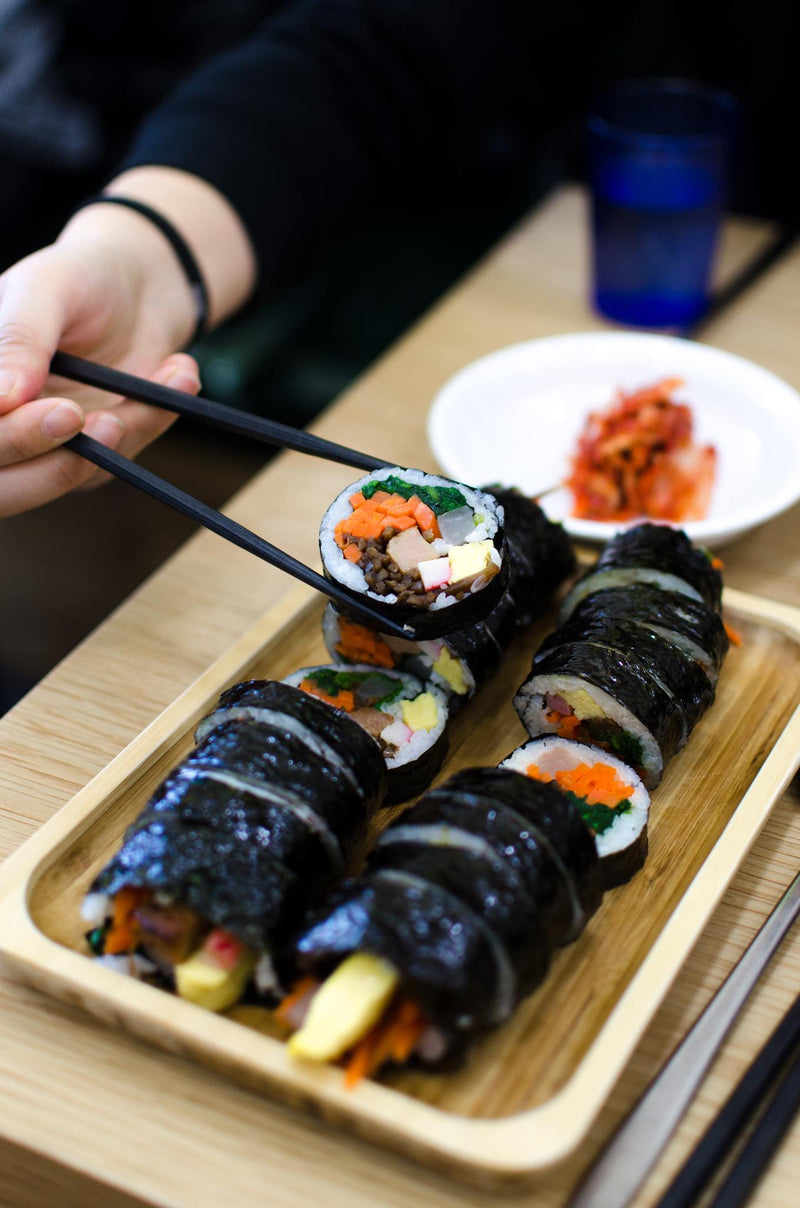What is kimbap & how is it different from sushi?

According to a recent analysis, sushi is the most popular food on Instagram (the world over) and it’s easy to see why. But due to our familiarity with sushi, a first look at kimbap and you’ll probably see it as a slightly different looking type of sushi — but this isn’t the case — kimbap has its own identity! And if you love eating sushi, but raw fish sushi isn’t your favourite, kimbap might just be your new best friend…
What is kimbap?
The name kimbap (gimbap) translates as seaweed (kim) and rice (bap). You might also hear kimbap being called ‘Korean sushi’ due to the similarity in appearance, but it’s a shame to call kimbap this, as kimbap has its own distinctiveness. Plus, there is a debate about what was invented first: sushi or kimbap (we won’t get involved).
Types of kimbap
There are three main types of kimbap:
- Traditional kimbap — made with rice, seaweed and filling.
- Nude or French kimbap — with seaweed on the inside and rice on the outside.
- Samgak kimbap — a cute and handy triangle-shaped kimbap which is sold in convenience shops in South Korea, covered in a plastic wrapper. Samgak kimbap wasn’t introduced until the early 90s (inspired by Japanese rice balls) but it is filled with Korean delicacies like kimchi, bulgogi and bibimbap.
Within these three types of kimbap you have endless styles such as:
Mayak kimbap – this is the most popular variety of kimbap. This mini kimbap is like the traditional kimbap, with all the usual fillings (rice and pickled veg wrapped in seaweed) but it’s never sliced. So it remains in a long roll (but mini in size). They are served as little stacks of cylinder rolls with dips such as soy sauce and mustard. Heaven on a plate.
Chamchi kimbap — this variety of kimbap has lots of filling (tuna) and less rice wrapped in seaweed, making them substantial circles of filling. As well as the tuna, they may also include vegetables (fresh or pickled), eggs and fish cakes.
Chungmu kimbap – this kimbap is made with only rice as the filler ingredient, wrapped in seaweed. That makes these rolls thin and cylindrical. They are served with spicy squid and radish salad to add flavour.
What is the difference between sushi and kimbap?
Sushi usually features raw fish, seafood, vegetables and rice seasoned with sushi vinegar. The name ‘sushi’ refers to this vinegared rice. Whereas, kimbap rice is seasoned with sesame oil and doesn’t contain raw fish. Instead, kimbap fillings include meats like grilled bulgogi, or cheese, kimchi, ham and eggs. No wasabi or soy sauce is used with kimbap; kimbap is served with pickled vegetables and kimchi. In Korea, kimbap just refers to rice rolled in seaweed. In Japan, sushi can include numerous dishes that use vinegared rice.
Type of rice
Both sushi and kimbap use cooked, short-grain white rice, just seasoned differently. We commonly know this sticky rice as sushi rice. Kimbap has a slightly sweeter taste compared with sushi due to the kimbap rice being seasoned with sesame oil and the sushi rice seasoned with vinegar. But Korean kimbap can also use brown rice, black rice and quinoa — all great for upping the nutritional value.
Type of fillings
As sushi often contains raw fish, it must be eaten fresh, whereas kimbap will keep longer due to the different types of fillings. The common kimbap doesn’t contain any raw fish, but contains protein in the form of imitation crab meat, processed luncheon meat, beef, eggs and fishcake. Kimbap also includes vegetables such as pickled radish, spinach and carrot. However, Koreans love to add other ingredients to kimbap such as kimchi, ham, cheese and Korean BBQ. Kimbap uses more common ingredients so it can be seen as more accessible and less expensive when compared to sushi.
Similarities between kimbap and sushi
There are of course a few similarities. Kimbap and sushi both use nori sheets to wrap up the rice and fillings (the seaweed on kimbap is often brushed with sesame oil, whereas sushi seaweed is kept plain). Both kimbap and sushi use cooked short-grain rice and both are rolled using a bamboo mat. They also both have a large number of variations to choose from!
Kimbap and sushi taste equally delectable and uniquely different. We are just so glad that both sushi and kimbap exist and we hope that you relish in their differences.



